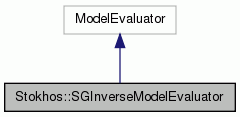|
Stokhos
Development
|
|
Stokhos
Development
|
Nonlinear, inverse stochastic Galerkin ModelEvaluator. More...
#include <Stokhos_SGInverseModelEvaluator.hpp>


Public Member Functions | |
| SGInverseModelEvaluator (const Teuchos::RCP< EpetraExt::ModelEvaluator > &me, const Teuchos::Array< int > &sg_p_index_map, const Teuchos::Array< int > &sg_g_index_map, const Teuchos::Array< Teuchos::RCP< const Epetra_Map > > &base_g_maps) | |
Overridden from EpetraExt::ModelEvaluator . | |
| Teuchos::RCP< const Epetra_Map > | get_x_map () const |
| Return solution vector map. | |
| Teuchos::RCP< const Epetra_Map > | get_f_map () const |
| Return residual vector map. | |
| Teuchos::RCP< const Epetra_Map > | get_p_map (int l) const |
| Return parameter vector map. | |
| Teuchos::RCP< const Epetra_Map > | get_g_map (int l) const |
| Return response map. | |
|
Teuchos::RCP< const Teuchos::Array< std::string > > | get_p_names (int l) const |
| Return array of parameter names. | |
| Teuchos::RCP< const Epetra_Vector > | get_p_init (int l) const |
| Return initial parameters. | |
| InArgs | createInArgs () const |
| Create InArgs. | |
| OutArgs | createOutArgs () const |
| Create OutArgs. | |
| void | evalModel (const InArgs &inArgs, const OutArgs &outArgs) const |
| Evaluate model on InArgs. | |
Protected Attributes | |
|
Teuchos::RCP < EpetraExt::ModelEvaluator > | me |
| Underlying model evaluator. | |
| Teuchos::Array< int > | sg_p_index_map |
| Mapping between stochastic block parameters and sg parameters. | |
| Teuchos::Array< int > | sg_g_index_map |
| Mapping between stochastic block responses and sg responses. | |
|
Teuchos::Array< Teuchos::RCP < const Epetra_Map > > | base_g_maps |
| Base maps of block g vectors. | |
| int | num_p |
| Number of parameters. | |
| int | num_g |
| Number of responses. | |
| int | num_p_sg |
| Number of stochastic parameter vectors. | |
| int | num_g_sg |
| Number of stochastic response vectors. | |
Nonlinear, inverse stochastic Galerkin ModelEvaluator.
SGInverseModelEvaluator is an implementation of EpetraExt::ModelEvaluator that does the inverse of SGModelEvalutor, namely it takes SG versions of the p InArgs and g and dg/dp OutArgs, and converts them to block vectors that are passed to the underlying model evaluator. This allows block nonlinear problems to appear to SG problems.
 1.8.5
1.8.5